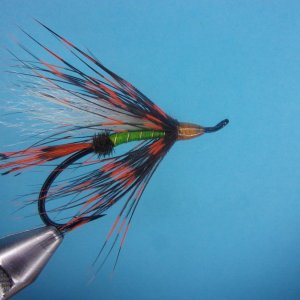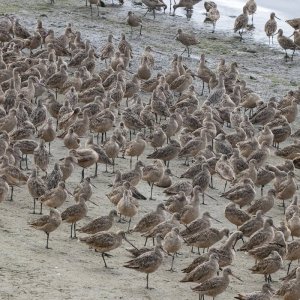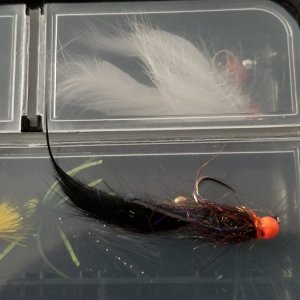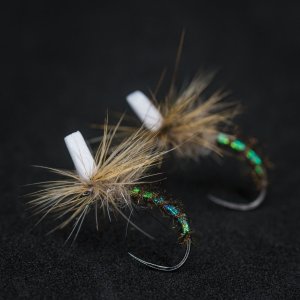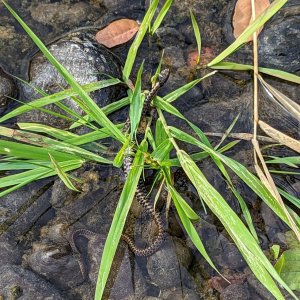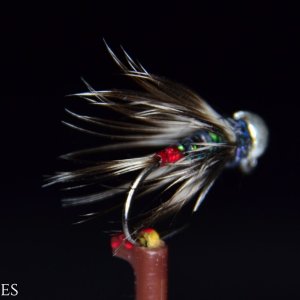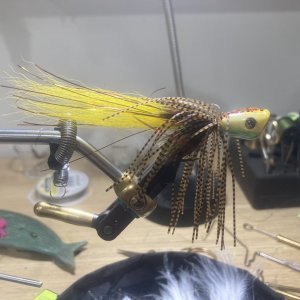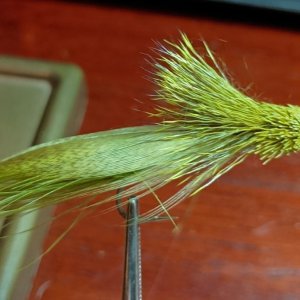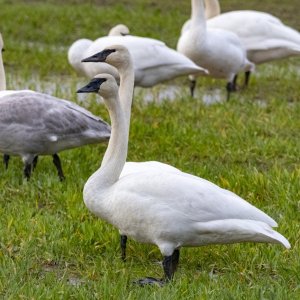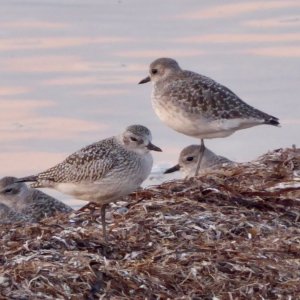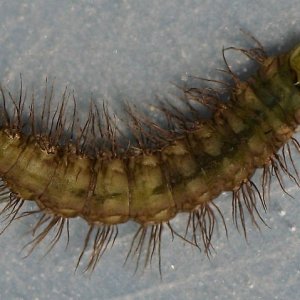Late August / early September was albacore tuna season for me: three offshore trips in 11 days out of Westport, WA with the wonderful folks at All Rivers (Merry is the best…). And now it appears to be over as I have this job thingy that cuts down fishing days. Soon enough, the fall storms will put the kybosh on these offshore trips and the tuna will swim away for warmer pastures in the Central and Western Pacific. And we will start to dream of next summer.
In the darkness and chill of January, I reserve several day-trips (private charters) with All Rivers to fish on the boat captained by the fly-master Captain @Nick Clayton. With the dates set, I then round up the other three anglers that will complete the 4-person angling crew for each of the trips. I have fished with these folks for several years – fun people and great anglers. I have been able to introduce friends and family to this unique fishery too. And every year, there is a new person or two who wants to try this crazy adventure. The total cost of a trip (charter, tip, carking of the tuna) runs about $670 per angler – not trivial but this is a world-class albacore fishery in our backyard (sensu lato). Fortunately, we and Nick have enough extra rods, etc. to outfit the newbies.
The spring is spent kibitzing (think hot-stove league in baseball’s offseason) – discussing, tying, and critiquing new fly patterns that might be the hot ticket for this summer. As spring transitions into summer, we engage in wild, mildly-informed speculation on the impact of the current oceanographic conditions, like La Nina this summer, on the upcoming albacore fishing season. Finally, by mid-July, the first albacore fishing reports roll in and our excitement rises. A week or less before my first trip, I start going through my gear and running all the things that I need to bring through my mind. Two nights before I receive a call or text from Merry at All-Rivers telling me that the weather is good, the trip is a go, and departure time is 5:30AM. I pass on this information to the other anglers. Most of my gear is packed in the 4-Runner the evening before and I place a scopolamine patch behind my ear to counter seasickness before heading to bed. Most of the other anglers are camping or staying in motels in Westport, but I live just close enough that I prefer to sleep in my own bed and drive to Westport in the wee hours before the trip. My alarm is set for 3:15AM (ugghhh) and like an 8-year-old on Christmas eve, it isn’t easy to fall sleep due to the excitement. I won’t be home until 7ish, a long 16-hour day. Today, I wake a few minutes before my alarm goes off and I just go with it.
After packing my lunch (which I never do eat because I never seem to take a break when we’re out on the water), I’m on the road for the 75-minute drive to Westport. It is pre-dawn when I arrive in the parking lot. I don my waterproof fishing pants, a rain coat, and old non-waterproof hiking boots. The look is clearly NOT fashionable, but the mate can hose me off when I’m covered in fresh tuna blood. There will be blood! Then, it is time to carry my heavy camera pack, my fishing bag with flies and fly reels, two rod tubes containing my 12 wt. fly rods, and my lunch and Gatorades from the parking area to the top of the dock.
The other anglers have arrived. We exchange hello’s and catch up. Then, it is time to head to the 28’ Defiance boat and say hi to Nick and his deck hand. Nick helps stow the gear while the mate prepares the boat for departure. After signing releases (that we never read. I still have no idea what I’ve signed off, probably my first-born (good luck with that)…), we all don inflatable life jackets that we will wear for the rest of the day. Nick provides a quick, but thorough, review of the safety procedures and equipment on the boat. We select our locations for the ride out. Those with steadier stomachs ride in the dry cabin. With my more delicate constitution, I prefer to sit on one of the outside seats aft of the cabin. The advantage of being outside is that there is more circulating fresh air and I can see the horizon which helps keep the contents of my stomach where they belong. And I often can see more wildlife too. The downside of this location is that the boat is always pounding into the prevailing swell from the west and this kicks up spray that runs over the cabin. It would shower on me in my exposed seating location except there is a rain fly overhead that diverts most (but not all) of the spray farther to the stern.
Nick starts the twin 250 horse-power outboards and the mate slips off the docking lines and pushes the stern away from the dock. Nick stops by the bait dock where the mate loads two or three brails (nets-full) of live anchovies into the large live well on the boat. We slowly motor through the marina and turn into the wide channel that separates Westport and Ocean Shores. It is calm in here, but the farther west we motor along the rock jetty, the more the swell builds. The waves are especially steep and sharp as we reach the Westport bar where the waters exiting the Chehalis River collide with the incoming waves of the mighty Pacific. Our journey has just begun; it is 50-70 miles from Westport to the fishing grounds where the tuna were found yesterday. Even at 20+ knots (less if the swell is up), the trip is going to take several hours. Several hours of pounding into the waves and spray flying over the cabin (and onto my legs and boots).
Finally, we’re there. Nick drops the engines into neutral and everyone prepares their fly rods and flies. Unlike the usual All-Rivers tuna-fishing clients who fish gear rods on the troll and live bait when stopped, we are all fly anglers. But we’re not using delicate graphite trout rods (“buggy-whips”) from a “River Runs Through It”. Our quarry would consider the trout in that movie as snacks. These are much beefier graphite rods with enough backbone to encourage a 25-pound albacore up to the boat (eventually). Attached to these rods are large reels with powerful drags to make an albacore work for every yard of line it pulls off the reel. The reels are spooled with up to 500 yards of backing and fast-sinking fly lines. That first explosive run of a tuna can rip off your whole 100’-long fly line and a few hundred yards of backing. And you will have to recover all of this line to land the fish. The flies that are tied to the leader at the end of the fly line resemble, albeit abstractly in some cases, the baitfish or squid that form the typical prey of albacore tuna. Some flies are weighted to increase sink rate and others are not. Each fly is 3-5” long with a strong stainless-steel hook.
Why do we do it? I have fallen in love with these offshore trips because they simultaneously scratch three of my itches: marine biology, flyfishing, and wildlife. Regarding the last (and the first), we often have dolphins (such as Pacific white-sided dolphins) playing in the wake of the boat and we pass spouting whales as we head to and from the fishing grounds. While I haven’t seen this myself, my friends have described encountering huge aggregations of dolphins offshore. Amazing. And we even encounter seals this far offshore.
Nearer to shore, we pass flocks of rhinoceros auklets and common murres that are actively feeding on the rich marine life in the cold (55oF) upwelled “green water” along the coast. Farther offshore where the water temperatures begin to increase, we begin to encounter pelagic bird species, especially flocks of sooty and pink-footed shearwaters. Majestic albatrosses with their amazingly-long wings glide effortlessly cross our path. Tiny storm petrels flutter their way just above the surface of the water. Jaegers which aggressively steal food from other birds, can also appear. In the clear blue, warm (above 60oF) waters of the tuna grounds, we keep our eyes peeled for terns and Bonaparte’s gulls. In the clear blue water, these birds often follow the roving schools of albacore tuna which will explode episodically at the surface as they attack baitfish.
In addition to our primary quarry – the amazing albacore tuna, we will often encounter one or two bizarre ocean sunfish (Mola mola) lolling at the surface. When we are at a bait stop and there’s bright red tuna blood running from the scuppers into the water, a curious blue-shark (they behave kind of like puppy dogs) may swim by. And on occasion, a blue shark will attack one of our flies during a stop and then it is game on. These we catch and release. There are even larger sharks out there, such as a cruising thresher shark or a jumping mako.
And you never know what else is out there – mahi mahi? (one caught by a friend off Garibaldi, OR a few days ago), bluefin tuna? (two caught by All Rivers boats this summer), yellowfin tuna? (I might have hooked one last summer under a floating kelp paddy), the enigmatic midwater opah? Then, there are the fish of our dreams/nightmares - the strikes where the fish just won’t be stopped no matter how tight you set the drag on your reel. You watch helplessly as your fly line and backing just melts off the reel and the knob on the reel is a rotating blur. At best, you hope to break the leader to recover your backing and fly line at least because you aren’t stopping this freight train. And then follows the endless speculation: “Just what was that?” and that will haunt you forever…
We fish for hours, mostly trolling at 4-5 knots with our flies and fly lines trailing behind the frothy boat wake. There are no rod-holders so you are holding the rod in your hand with a loop of fly line in your hand. You will know when the moment comes. Long periods of inactivity are pierced by crazy intensity when an albacore tuna streaks up from below to smash your fly. “Fish on”. The reel sings as that first fish strips off any wraps of fly line remaining the reel and then you are deep into the backing.
Nick drops the boat into neutral and the mate throws out a half dozen live anchovies to keep the school in the area. Anyone who hasn’t hooked up (and sometimes we can have three tuna strike nearly simultaneously while trolling) starts to strip in their fly as the boat begins to slow its momentum. This is the “slide”. This action often leads to a second or third hookup. In my experience, the record is five anglers (4 clients and Nick) hooked up simultaneously.
Once the boat is drifting in the waves, anyone who isn’t already hooked up finds a spot on the boat to cast out. Long, booming cast aren’t required here. Roll casts work. Let the fly sink a bit and strip it back. Or make a short cast, feed out more sinking fly line, and let the line carry the fly deeper into the water column (stack mending); then strip the fly back. Or just jig the fly up and down in the water column. While this is going on, the mate is dribbling out a few live anchovies to keep the school in the neighborhood and keeping an eye out for the progress of the tuna that are being fought. If your cast ends up near where tuna a crashing these sacrificial anchovies, be very ready; your fly is about to get crushed. And if the fish are really active at the surface, borrow Nick’s popper rod (or switch to your own). After casting out the popper, wake the fly back across the surface and wait for the explosion.
Back to our angler fighting an angry albacore. The fight starts out typically with the fish close to the surface but very far from the boat. You stop the first explosive run and start to gain some backing onto the reel. “Not so fast my friend”, the tuna says and it runs out all the backing you recovered and more. Hopefully, you keep your reeling hand clear of that reel handle because it is spinning like a top whether your fingers are in the way or not. Even with 12 wt. fly rod, you have limited control over the situation. And then the fish decides to run toward the boat; reel, reel, reel as fast as you can to keep pressure on the fish. Fortunately, these are barbed hooks.
As you finally begin to pull slowly, painfully, inexorably the fish closer to the boat, the albacore changes tactics and sounds. Your fly line is now vertical. The albacore now uses its massive pectoral fins as brakes as you try to pull it up to the surface. You need to keep constant pressure on the fish. If you stop reeling, it doesn’t tire. The best strategy is to just keep constant pressure. Pull up and reel down. Pull up and reel down. Repeat, repeat, repeat. Try to keep that fish angled up; don’t give it a chance to point its head down. If the fish decides to head under the boat to the other side, you have to swing your fly line around the engines or the bow. You aren’t dictating where the fish is going, it dictates to you.
Finally, you see the silvery flash of the fish’s belly 20-30 feet below you. You begin to think that the end is near. Au contraire, mon frere. You rest the pressure for a second and the fish turns and dives, stripping the fly line and a bit of backing off your reel again. Ugghh. Back to the grind.
But finally, you see the flash of silver again below you and you let the mate know to stay close with the gaff (not a catch-and-release fishery…). While the endgame is here, the dangers have actually increased. It is tempting to try to horse the fish up to the surface within the short range of the gaff. So, you grab higher up on the rod for more leverage – bad move, a great way to break a rod (don’t ask me how I know). Be patient, keep the pressure on. Now the fish is moving in circles just under the surface. You keep reeling though your muscles are screaming. One of those circles brings the fish close enough to the boat. The mate (or Nick) swings the gaff, sticks the fish, and hauls the fish over the gunnel. You have to strip off some line from your reel to avoid having the tip of your rod break from the tension of a 15-25 pound fish struggling in air. But if the mate misses (the fish movements can be unpredictable), the fish will dive and pull off line and you have to haul it back up for another try.
Once the fish in on the boat, be prepared for a shower of blood, initially from the gaff wound and then when the mate slits the ventral aorta leaving the heart to the gills. If this is the only fish being fought, the mate will slip the fish into one of the ice-filled fish boxes that run under the aft deck. This ice bath quickly cools the endothermic swimming muscles of the tuna and helps preserve the quality of the flesh.
But if there are other albacore to be gaffed, your fish will just be dropped on the deck until there is a break in the action. These fish don’t know that they are dead yet. They will beat their tails against the bloody deck furiously; blood flies everywhere. Then, quiet. Slide the fish into the fish box. The mate grabs a salt-water hose to rinse the blood off the deck (and you, as needed). Let’s keep things neat.
If there aren’t any fish on the fish finder or if we aren’t drawing any strikes on cast flies, Nick will kick the boat into gear and we will start to troll again. On some days, we will be trolling for less than a minute when we have another hit and the circus begins again. Other times, we will troll for a long period with nothing happening in spite of Nick changing speeds, changing directions, and changing locations. That’s fishing.
On rare days, the action is consistent and hot all day. More commonly, it is hot when we first arrive at the fishing grounds, goes quieter in late morning (albacore siesta time?), and starts to pick up again, albeit sporadically, in the early afternoon. But the clock is ticking and even if the action has started to pick up, our time is over. By Coast Guard regulation, Nick can only be an active captain for a fixed number of hours and we are still 50+ miles from Westport. Alas, it is time to reel in the rods, stow them in a safe spot (typically in the cuddy in the bow), and settle in for the trip back.
The ride back is more comfortable because we are traveling with the prevailing swell and Nick puts the hammer down. I can ride in the cabin almost comfortably on the way back to Westport. But the real show is happening on the aft deck. The mate pulls a mess of tuna out of the fish box and “cark” (process) them on a cutting table set up over the live-bait tank. In about a minute and with about 10 cuts with a sharp fillet knife on each carcass, he will remove the tuna belly, the skin and the two loins from each side from the carcass, and fling the skeleton over the side. The clients who are sitting in those aft outside seats help him place the 4 loins (2 per side) and the belly of each fish into a plastic bag. These are then stored on ice in a large cooler just forward of the live-bait tank. And the mate is doing this while the boat is rocking and pounding with the seas. Once the fish are “carked”, he begins the process of cleaning the boat with hose and a brush. Tuna blood seems to find places everywhere.
Hours later, land draws closer and closer. We begin to see navigation buoys and finally the Westport breakwater. We turn the corner of the breakwater protecting the Westport marina itself and are soon at the dock, typically the last of the All River fleet to return because Nick has kept us out to the last possible minute. We settle the balance of charter cost (I fronted the deposit in January and have already been reimbursed typically), tip Nick and the mate (they split all tips), and pay the mate for carking the albacore ($4 per fish). It will take two trips to unload everything. I load up my gear et al. and hike back to the ForeRunner. I return with my cooler and on a second trip, grab my share of the catch, add some ice from the boat’s cooler to mine, and carry it back up to the ForeRunner. No matter how hot or cold the fishing was, we all had a good day. We are tired, wind-burned often, maybe a little sunburnt, dehydrated. We say our goodbyes. In an hour and a half or so, I’m home. Until the next trip. Until next year.
Steve
In the darkness and chill of January, I reserve several day-trips (private charters) with All Rivers to fish on the boat captained by the fly-master Captain @Nick Clayton. With the dates set, I then round up the other three anglers that will complete the 4-person angling crew for each of the trips. I have fished with these folks for several years – fun people and great anglers. I have been able to introduce friends and family to this unique fishery too. And every year, there is a new person or two who wants to try this crazy adventure. The total cost of a trip (charter, tip, carking of the tuna) runs about $670 per angler – not trivial but this is a world-class albacore fishery in our backyard (sensu lato). Fortunately, we and Nick have enough extra rods, etc. to outfit the newbies.
The spring is spent kibitzing (think hot-stove league in baseball’s offseason) – discussing, tying, and critiquing new fly patterns that might be the hot ticket for this summer. As spring transitions into summer, we engage in wild, mildly-informed speculation on the impact of the current oceanographic conditions, like La Nina this summer, on the upcoming albacore fishing season. Finally, by mid-July, the first albacore fishing reports roll in and our excitement rises. A week or less before my first trip, I start going through my gear and running all the things that I need to bring through my mind. Two nights before I receive a call or text from Merry at All-Rivers telling me that the weather is good, the trip is a go, and departure time is 5:30AM. I pass on this information to the other anglers. Most of my gear is packed in the 4-Runner the evening before and I place a scopolamine patch behind my ear to counter seasickness before heading to bed. Most of the other anglers are camping or staying in motels in Westport, but I live just close enough that I prefer to sleep in my own bed and drive to Westport in the wee hours before the trip. My alarm is set for 3:15AM (ugghhh) and like an 8-year-old on Christmas eve, it isn’t easy to fall sleep due to the excitement. I won’t be home until 7ish, a long 16-hour day. Today, I wake a few minutes before my alarm goes off and I just go with it.
After packing my lunch (which I never do eat because I never seem to take a break when we’re out on the water), I’m on the road for the 75-minute drive to Westport. It is pre-dawn when I arrive in the parking lot. I don my waterproof fishing pants, a rain coat, and old non-waterproof hiking boots. The look is clearly NOT fashionable, but the mate can hose me off when I’m covered in fresh tuna blood. There will be blood! Then, it is time to carry my heavy camera pack, my fishing bag with flies and fly reels, two rod tubes containing my 12 wt. fly rods, and my lunch and Gatorades from the parking area to the top of the dock.
The other anglers have arrived. We exchange hello’s and catch up. Then, it is time to head to the 28’ Defiance boat and say hi to Nick and his deck hand. Nick helps stow the gear while the mate prepares the boat for departure. After signing releases (that we never read. I still have no idea what I’ve signed off, probably my first-born (good luck with that)…), we all don inflatable life jackets that we will wear for the rest of the day. Nick provides a quick, but thorough, review of the safety procedures and equipment on the boat. We select our locations for the ride out. Those with steadier stomachs ride in the dry cabin. With my more delicate constitution, I prefer to sit on one of the outside seats aft of the cabin. The advantage of being outside is that there is more circulating fresh air and I can see the horizon which helps keep the contents of my stomach where they belong. And I often can see more wildlife too. The downside of this location is that the boat is always pounding into the prevailing swell from the west and this kicks up spray that runs over the cabin. It would shower on me in my exposed seating location except there is a rain fly overhead that diverts most (but not all) of the spray farther to the stern.
Nick starts the twin 250 horse-power outboards and the mate slips off the docking lines and pushes the stern away from the dock. Nick stops by the bait dock where the mate loads two or three brails (nets-full) of live anchovies into the large live well on the boat. We slowly motor through the marina and turn into the wide channel that separates Westport and Ocean Shores. It is calm in here, but the farther west we motor along the rock jetty, the more the swell builds. The waves are especially steep and sharp as we reach the Westport bar where the waters exiting the Chehalis River collide with the incoming waves of the mighty Pacific. Our journey has just begun; it is 50-70 miles from Westport to the fishing grounds where the tuna were found yesterday. Even at 20+ knots (less if the swell is up), the trip is going to take several hours. Several hours of pounding into the waves and spray flying over the cabin (and onto my legs and boots).
Finally, we’re there. Nick drops the engines into neutral and everyone prepares their fly rods and flies. Unlike the usual All-Rivers tuna-fishing clients who fish gear rods on the troll and live bait when stopped, we are all fly anglers. But we’re not using delicate graphite trout rods (“buggy-whips”) from a “River Runs Through It”. Our quarry would consider the trout in that movie as snacks. These are much beefier graphite rods with enough backbone to encourage a 25-pound albacore up to the boat (eventually). Attached to these rods are large reels with powerful drags to make an albacore work for every yard of line it pulls off the reel. The reels are spooled with up to 500 yards of backing and fast-sinking fly lines. That first explosive run of a tuna can rip off your whole 100’-long fly line and a few hundred yards of backing. And you will have to recover all of this line to land the fish. The flies that are tied to the leader at the end of the fly line resemble, albeit abstractly in some cases, the baitfish or squid that form the typical prey of albacore tuna. Some flies are weighted to increase sink rate and others are not. Each fly is 3-5” long with a strong stainless-steel hook.
Why do we do it? I have fallen in love with these offshore trips because they simultaneously scratch three of my itches: marine biology, flyfishing, and wildlife. Regarding the last (and the first), we often have dolphins (such as Pacific white-sided dolphins) playing in the wake of the boat and we pass spouting whales as we head to and from the fishing grounds. While I haven’t seen this myself, my friends have described encountering huge aggregations of dolphins offshore. Amazing. And we even encounter seals this far offshore.
Nearer to shore, we pass flocks of rhinoceros auklets and common murres that are actively feeding on the rich marine life in the cold (55oF) upwelled “green water” along the coast. Farther offshore where the water temperatures begin to increase, we begin to encounter pelagic bird species, especially flocks of sooty and pink-footed shearwaters. Majestic albatrosses with their amazingly-long wings glide effortlessly cross our path. Tiny storm petrels flutter their way just above the surface of the water. Jaegers which aggressively steal food from other birds, can also appear. In the clear blue, warm (above 60oF) waters of the tuna grounds, we keep our eyes peeled for terns and Bonaparte’s gulls. In the clear blue water, these birds often follow the roving schools of albacore tuna which will explode episodically at the surface as they attack baitfish.
In addition to our primary quarry – the amazing albacore tuna, we will often encounter one or two bizarre ocean sunfish (Mola mola) lolling at the surface. When we are at a bait stop and there’s bright red tuna blood running from the scuppers into the water, a curious blue-shark (they behave kind of like puppy dogs) may swim by. And on occasion, a blue shark will attack one of our flies during a stop and then it is game on. These we catch and release. There are even larger sharks out there, such as a cruising thresher shark or a jumping mako.
And you never know what else is out there – mahi mahi? (one caught by a friend off Garibaldi, OR a few days ago), bluefin tuna? (two caught by All Rivers boats this summer), yellowfin tuna? (I might have hooked one last summer under a floating kelp paddy), the enigmatic midwater opah? Then, there are the fish of our dreams/nightmares - the strikes where the fish just won’t be stopped no matter how tight you set the drag on your reel. You watch helplessly as your fly line and backing just melts off the reel and the knob on the reel is a rotating blur. At best, you hope to break the leader to recover your backing and fly line at least because you aren’t stopping this freight train. And then follows the endless speculation: “Just what was that?” and that will haunt you forever…
We fish for hours, mostly trolling at 4-5 knots with our flies and fly lines trailing behind the frothy boat wake. There are no rod-holders so you are holding the rod in your hand with a loop of fly line in your hand. You will know when the moment comes. Long periods of inactivity are pierced by crazy intensity when an albacore tuna streaks up from below to smash your fly. “Fish on”. The reel sings as that first fish strips off any wraps of fly line remaining the reel and then you are deep into the backing.
Nick drops the boat into neutral and the mate throws out a half dozen live anchovies to keep the school in the area. Anyone who hasn’t hooked up (and sometimes we can have three tuna strike nearly simultaneously while trolling) starts to strip in their fly as the boat begins to slow its momentum. This is the “slide”. This action often leads to a second or third hookup. In my experience, the record is five anglers (4 clients and Nick) hooked up simultaneously.
Once the boat is drifting in the waves, anyone who isn’t already hooked up finds a spot on the boat to cast out. Long, booming cast aren’t required here. Roll casts work. Let the fly sink a bit and strip it back. Or make a short cast, feed out more sinking fly line, and let the line carry the fly deeper into the water column (stack mending); then strip the fly back. Or just jig the fly up and down in the water column. While this is going on, the mate is dribbling out a few live anchovies to keep the school in the neighborhood and keeping an eye out for the progress of the tuna that are being fought. If your cast ends up near where tuna a crashing these sacrificial anchovies, be very ready; your fly is about to get crushed. And if the fish are really active at the surface, borrow Nick’s popper rod (or switch to your own). After casting out the popper, wake the fly back across the surface and wait for the explosion.
Back to our angler fighting an angry albacore. The fight starts out typically with the fish close to the surface but very far from the boat. You stop the first explosive run and start to gain some backing onto the reel. “Not so fast my friend”, the tuna says and it runs out all the backing you recovered and more. Hopefully, you keep your reeling hand clear of that reel handle because it is spinning like a top whether your fingers are in the way or not. Even with 12 wt. fly rod, you have limited control over the situation. And then the fish decides to run toward the boat; reel, reel, reel as fast as you can to keep pressure on the fish. Fortunately, these are barbed hooks.
As you finally begin to pull slowly, painfully, inexorably the fish closer to the boat, the albacore changes tactics and sounds. Your fly line is now vertical. The albacore now uses its massive pectoral fins as brakes as you try to pull it up to the surface. You need to keep constant pressure on the fish. If you stop reeling, it doesn’t tire. The best strategy is to just keep constant pressure. Pull up and reel down. Pull up and reel down. Repeat, repeat, repeat. Try to keep that fish angled up; don’t give it a chance to point its head down. If the fish decides to head under the boat to the other side, you have to swing your fly line around the engines or the bow. You aren’t dictating where the fish is going, it dictates to you.
Finally, you see the silvery flash of the fish’s belly 20-30 feet below you. You begin to think that the end is near. Au contraire, mon frere. You rest the pressure for a second and the fish turns and dives, stripping the fly line and a bit of backing off your reel again. Ugghh. Back to the grind.
But finally, you see the flash of silver again below you and you let the mate know to stay close with the gaff (not a catch-and-release fishery…). While the endgame is here, the dangers have actually increased. It is tempting to try to horse the fish up to the surface within the short range of the gaff. So, you grab higher up on the rod for more leverage – bad move, a great way to break a rod (don’t ask me how I know). Be patient, keep the pressure on. Now the fish is moving in circles just under the surface. You keep reeling though your muscles are screaming. One of those circles brings the fish close enough to the boat. The mate (or Nick) swings the gaff, sticks the fish, and hauls the fish over the gunnel. You have to strip off some line from your reel to avoid having the tip of your rod break from the tension of a 15-25 pound fish struggling in air. But if the mate misses (the fish movements can be unpredictable), the fish will dive and pull off line and you have to haul it back up for another try.
Once the fish in on the boat, be prepared for a shower of blood, initially from the gaff wound and then when the mate slits the ventral aorta leaving the heart to the gills. If this is the only fish being fought, the mate will slip the fish into one of the ice-filled fish boxes that run under the aft deck. This ice bath quickly cools the endothermic swimming muscles of the tuna and helps preserve the quality of the flesh.
But if there are other albacore to be gaffed, your fish will just be dropped on the deck until there is a break in the action. These fish don’t know that they are dead yet. They will beat their tails against the bloody deck furiously; blood flies everywhere. Then, quiet. Slide the fish into the fish box. The mate grabs a salt-water hose to rinse the blood off the deck (and you, as needed). Let’s keep things neat.
If there aren’t any fish on the fish finder or if we aren’t drawing any strikes on cast flies, Nick will kick the boat into gear and we will start to troll again. On some days, we will be trolling for less than a minute when we have another hit and the circus begins again. Other times, we will troll for a long period with nothing happening in spite of Nick changing speeds, changing directions, and changing locations. That’s fishing.
On rare days, the action is consistent and hot all day. More commonly, it is hot when we first arrive at the fishing grounds, goes quieter in late morning (albacore siesta time?), and starts to pick up again, albeit sporadically, in the early afternoon. But the clock is ticking and even if the action has started to pick up, our time is over. By Coast Guard regulation, Nick can only be an active captain for a fixed number of hours and we are still 50+ miles from Westport. Alas, it is time to reel in the rods, stow them in a safe spot (typically in the cuddy in the bow), and settle in for the trip back.
The ride back is more comfortable because we are traveling with the prevailing swell and Nick puts the hammer down. I can ride in the cabin almost comfortably on the way back to Westport. But the real show is happening on the aft deck. The mate pulls a mess of tuna out of the fish box and “cark” (process) them on a cutting table set up over the live-bait tank. In about a minute and with about 10 cuts with a sharp fillet knife on each carcass, he will remove the tuna belly, the skin and the two loins from each side from the carcass, and fling the skeleton over the side. The clients who are sitting in those aft outside seats help him place the 4 loins (2 per side) and the belly of each fish into a plastic bag. These are then stored on ice in a large cooler just forward of the live-bait tank. And the mate is doing this while the boat is rocking and pounding with the seas. Once the fish are “carked”, he begins the process of cleaning the boat with hose and a brush. Tuna blood seems to find places everywhere.
Hours later, land draws closer and closer. We begin to see navigation buoys and finally the Westport breakwater. We turn the corner of the breakwater protecting the Westport marina itself and are soon at the dock, typically the last of the All River fleet to return because Nick has kept us out to the last possible minute. We settle the balance of charter cost (I fronted the deposit in January and have already been reimbursed typically), tip Nick and the mate (they split all tips), and pay the mate for carking the albacore ($4 per fish). It will take two trips to unload everything. I load up my gear et al. and hike back to the ForeRunner. I return with my cooler and on a second trip, grab my share of the catch, add some ice from the boat’s cooler to mine, and carry it back up to the ForeRunner. No matter how hot or cold the fishing was, we all had a good day. We are tired, wind-burned often, maybe a little sunburnt, dehydrated. We say our goodbyes. In an hour and a half or so, I’m home. Until the next trip. Until next year.
Steve
Last edited:

